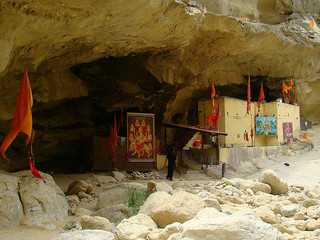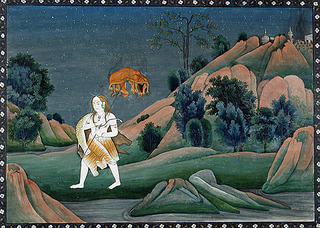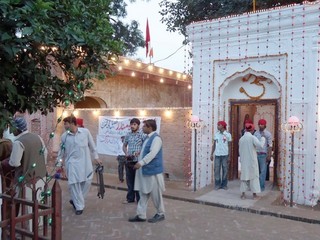Pakistan’s long forgotten Hindu temples
Katasraj temple
Katasraj temple
Katasraj temple
Another legend involves the death of Shiva’s wife Sati; the story goes that when she died he cried so much and for so long that his tears created two holy ponds – one at Pushkara in Ajmer and the other at Ketaksha, which literally means “raining eyes” in Sanskrit. It is from this name that the word Ketas is derived. Another version of the legend mentions the two pools at Katasraj and Nainital
 The pilgrims bathe in the sacred pool and seek forgiveness as a belief holds that bathing in the pond (especially on certain occasions) leads to the forgiveness of sins and helps attain salvation. Until recently, it was believed that the pond had unlimited depth
The pilgrims bathe in the sacred pool and seek forgiveness as a belief holds that bathing in the pond (especially on certain occasions) leads to the forgiveness of sins and helps attain salvation. Until recently, it was believed that the pond had unlimited depth
For decades the temple complex was in bad state. The holy pond was littered with garbage,  while the murals inside the temples disappeared due to the ravages of time and the neglect of the authorities. In 2006-07, Pakistan governments decided to place murtis of Hindu gods in the seven mandirs and restore them to their original state to attract visitors
while the murals inside the temples disappeared due to the ravages of time and the neglect of the authorities. In 2006-07, Pakistan governments decided to place murtis of Hindu gods in the seven mandirs and restore them to their original state to attract visitors
The Katas site houses the Satgraha, a group of seven ancient temples, remains of a  Buddhist stupa, a few medieval temples, havelis and some recently constructed temples, scattered around a pond. The mandir has two jharokas (balconies) that have been severely damaged. The temple’s ceiling is undecorated, and lime-plastered
Buddhist stupa, a few medieval temples, havelis and some recently constructed temples, scattered around a pond. The mandir has two jharokas (balconies) that have been severely damaged. The temple’s ceiling is undecorated, and lime-plastered
Hinglaj temple
An important Shakti Peeth of Goddess Sati, Hinglaj Mandir or Nani Mandir is situated in Baluchistan province of Pakistan. It came into existence when Lord Vishnu cut up Sati’s dead body into 52 pieces so that Lord Shiva would calm down and stop his Tandava. These pieces got scattered all over the Indian subcontinent whilst Sati’s head fell at Hingula or Hinglaj
According to ancient scriptures, Lord Rama had also meditated at Hinglaj to atone for his sin  of ‘Brahmhatya’ – killing of Ravana who was a Brahmin and a great devotee of Lord Shiva and Goddess Durga. Each year they organize a grand cultural-fair at this temple. Muslim residents actively take part in this celebration. They worship the Goddess with the same devotion as Hindus
of ‘Brahmhatya’ – killing of Ravana who was a Brahmin and a great devotee of Lord Shiva and Goddess Durga. Each year they organize a grand cultural-fair at this temple. Muslim residents actively take part in this celebration. They worship the Goddess with the same devotion as Hindus
The temple is not in a very good state. The chairman of the committee that manages the  famous Hinglaj Mata temple was kidnapped just two days before the beginning of the shrine’s annual pilgrimage, according to a media report in April 2012
famous Hinglaj Mata temple was kidnapped just two days before the beginning of the shrine’s annual pilgrimage, according to a media report in April 2012
Gori temple
The Jain temples of Tharparkar are among Pakistan’s major archaeological monuments. The most impressive of them all, Gori Temple, is located in the village of Gori between Islamkot and Nagarparkar in Tharparkar district. This partly ruined temple is mysterious since it has been abandoned for a long time. Authors in the past have yearned to find out about the current status of this long lost place of worship
 the 8th century BC. Several Jain texts give an account of the history of the temple and legends surrounding it. The text “Shri Gaudi Parshvanath Stavan” by Nemavijaya was written in Tharparkar region itself. The temple is built in the classical Jain style. It has one main temple surrounded by 52 smaller shrines, each housing one or more images of Jain prophets. It has 52 domes and its interiors were adorned with paintings
the 8th century BC. Several Jain texts give an account of the history of the temple and legends surrounding it. The text “Shri Gaudi Parshvanath Stavan” by Nemavijaya was written in Tharparkar region itself. The temple is built in the classical Jain style. It has one main temple surrounded by 52 smaller shrines, each housing one or more images of Jain prophets. It has 52 domes and its interiors were adorned with paintings still something that makes the Gori temple unique – the paintings within the ranga-mandap dome. These paintings are older than any other frescos in the Jain temples of North India, with the exception of Ellora. In India, the temples have been renovated and any old frescos have been painted over. Gori paintings are also older than any other surviving frescos in Pakistan, with the possible exception of some Gandhara fragments
still something that makes the Gori temple unique – the paintings within the ranga-mandap dome. These paintings are older than any other frescos in the Jain temples of North India, with the exception of Ellora. In India, the temples have been renovated and any old frescos have been painted over. Gori paintings are also older than any other surviving frescos in Pakistan, with the possible exception of some Gandhara fragmentsMari Indus temple
High above the mighty Indus temples were built from the sixth to the eleventh centuries A.D. Largely ignored by scholarship in this century, and orphaned since partition, these structures form an important missing link in the history of architecture. The far northwest in ancient India what now is the Northwest provinces of Pakistan, Swat, and parts of Afghanistan has many structural remains we can associate with Hindu mythology
Sharada Peeth
It is one of the most established Shakti Peethas formed due to the falling of body parts of the corpse  of Sati Devi, when Shiva carried it and wandered throughout Aryavartha in sorrow. There are 51 Shakti Peeth linking to the 51 alphabets in Sanskrit. Each temple has shrines for Shakti and Kalabhairava. Sharada Peeth is one of the 18 Maha Shakti Peetha. Devi’s Right hand is said to have fallen here. The Shakti worshiped here is the goddess of knowledge, Saraswathi otherwise known as Sharada
of Sati Devi, when Shiva carried it and wandered throughout Aryavartha in sorrow. There are 51 Shakti Peeth linking to the 51 alphabets in Sanskrit. Each temple has shrines for Shakti and Kalabhairava. Sharada Peeth is one of the 18 Maha Shakti Peetha. Devi’s Right hand is said to have fallen here. The Shakti worshiped here is the goddess of knowledge, Saraswathi otherwise known as Sharada
 eighth day of the Shukla Paksha, and devotees from all over India, flocked the place in thousands, for receiving the blessings of the Mother Sharada deity. There is a place called “Tikkar” at a distance of one and half kilometers from Kupwara, in Kashmir. From here, there is a short cut for going to Shardi which measures 40 kilometers. Many Pilgrims treaded this path only.
eighth day of the Shukla Paksha, and devotees from all over India, flocked the place in thousands, for receiving the blessings of the Mother Sharada deity. There is a place called “Tikkar” at a distance of one and half kilometers from Kupwara, in Kashmir. From here, there is a short cut for going to Shardi which measures 40 kilometers. Many Pilgrims treaded this path only.
Guru Gorakhnath temple
The Gorakhnath temple is named after the Guru Gorakhnath achieved prosperity in this city and also influenced followers with his teachings. It is said that this temple was built on the spot where Gorakhnath did meditation in Treta Yug. The temple is situated in the Gorgathri neighbourhood in Peshawar. Gorakhnath temple was reopened in 2011 after a long legal fight or 60 years as the temple was forcefully closed by the Evacuee Property Trust Board and the Provincial Archaeology Department of Pakistan
READ MORE AT :













